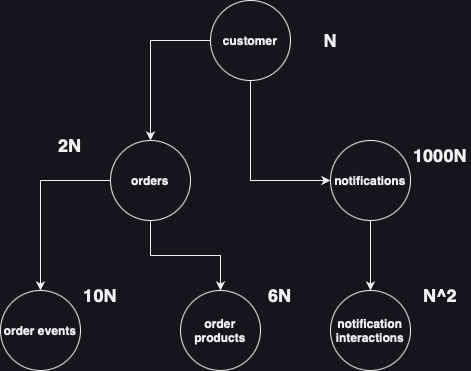Leveraging graph data structures for complex feature engineering pipelines.
Project description
GraphReduce
Description
GraphReduce is an abstraction for building machine learning feature engineering pipelines that involve many tables in a composable way. The library is intended to help bridge the gap between research feature definitions and production deployment without the overhead of a full feature store. Underneath the hood, GraphReduce uses graph data structures to represent tables/files as nodes and foreign keys as edges.
Compute backends supported: pandas, dask, and spark.
Compute backends coming soon: ray
Installation
# from pypi
pip install graphreduce
# from github
pip install 'graphreduce@git+https://github.com/wesmadrigal/graphreduce.git'
# install from source
git clone https://github.com/wesmadrigal/graphreduce && cd graphreduce && python setup.py install
Motivation
Machine learning requires vectors of data, but our tabular datasets
are disconnected. They can be represented as a graph, where tables
are nodes and join keys are edges. In many model building scenarios
there isn't a nice ML-ready vector waiting for us, so we must curate
the data by joining many tables together to flatten them into a vector.
This is the problem graphreduce sets out to solve.
An example dataset might look like the following:
To get this example schema ready for an ML model we need to do the following:
- define the node-level interface and operations for filtering, annotating, normalizing, and reducing
- select the granularity) to which we'll reduce our data: in this example
customer - specify how much historical data will be included and what holdout period will be used (e.g., 365 days of historical data and 1 month of holdout data for labels)
- filter all data entities to include specified amount of history to prevent data leakage
- depth first, bottom up aggregation operations group by / aggregation operations to reduce data
- Define the node-level interface and operations
import datetime
from graphreduce.node import GraphReduceNode
from graphreduce.enum import ComputeLayerEnum, PeriodUnit
from graphreduce.graph_reduce import GraphReduce
# Convention over configuration requires that we
# define boilerplate code for every entity / node
# we will compute over.
class CustomerNode(GraphReduceNode):
def do_annotate(self):
pass
def do_filters(self):
# Apply a filter operation on a hypothetical column `is_fake`.
# The `colabbr` method makes sure to prefix the column with
# the class or instance prefix.
self.df = self.df[self.df[self.colabbr('is_fake')] == False]
def do_normalize(self):
pass
def do_post_join_annotate(self):
pass
def do_reduce(self, reduce_key, *args, **kwargs):
pass
def do_labels(self, reduce_key, *args, **kwargs):
pass
class OrderNode(GraphReduceNode):
def do_annotate(self):
pass
def do_filters(self):
pass
def do_normalize(self):
pass
def do_post_join_annotate(self):
pass
def do_reduce(self, reduce_key):
# The `prep_for_features` method ensures no leakage
# prior to the compute period or after the cut date.
return self.prep_for_features().groupby(self.colabbr(reduce_key)).agg(
**{
self.colabbr(f'{self.pk}_count') : pd.NamedAgg(column=self.colabbr(self.pk), aggfunc='count')
}
).reset_index()
def do_labels(self, key):
pass
- Instantiate the nodes and define the graph
cust = CustomerNode(pk='id', prefix='cust',fpath='dat/cust.csv', fmt='csv', compute_layer=ComputeLayerEnum.pandas)
order = OrderNode(pk='id', prefix='order', fpath='dat/orders.csv', fmt='csv',compute_layer=ComputeLayerEnum.pandas)
gr = GraphReduce(
cut_date=datetime.datetime(2023, 5, 6),
compute_period_val=365,
compute_period_unit=PeriodUnit.day,
parent_node=cust,
compute_layer=ComputeLayerEnum.pandas,
has_labels=False,
label_period_val=30,
label_period_unit=PeriodUnit.day,
dynamic_propagation=True
)
# Add nodes and edges to the graph
gr.add_node(cust)
gr.add_node(order)
gr.add_entity_edge(
parent_node=cust,
relation_node=order,
parent_key='id',
relation_key='customer_id',
relation_type='parent_child',
reduce=True
)
- Plot the graph reduce compute graph.
gr.plot_graph('my_graph_reduce.html')
- Run compute operations
gr.do_transformations()
2023-08-03 09:05:44 [info ] hydrating graph attributes
2023-08-03 09:05:44 [info ] hydrating attributes for CustomerNode
2023-08-03 09:05:44 [info ] hydrating attributes for OrderNode
2023-08-03 09:05:44 [info ] hydrating graph data
2023-08-03 09:05:44 [info ] checking for prefix uniqueness
2023-08-03 09:05:44 [info ] running filters, normalize, and annotations for CustomerNode
2023-08-03 09:05:44 [info ] running filters, normalize, and annotations for OrderNode
2023-08-03 09:05:44 [info ] depth-first traversal through the graph from source: CustomerNode
2023-08-03 09:05:44 [info ] reducing relation OrderNode
2023-08-03 09:05:44 [info ] doing dynamic propagation on node OrderNode
2023-08-03 09:05:44 [info ] joining OrderNode to CustomerNode
- Use materialized dataframe for ML / analytics
gr.df.head()
cust_id cust_name order_customer_id order_id_count order_id_min order_id_max order_id_sum order_customer_id_min order_customer_id_max order_customer_id_sum order_ts_first
0 1 wes 1 2 1 2 3 1 1 2 2023-05-12
1 2 john 2 2 3 4 7 2 2 4 2023-01-01
order of operations
API definition
GraphReduce instantiation and parameters
graphreduce.graph_reduce.GraphReduce
cut_datecontrols the date around which we orient the data in the graphcompute_period_valcontrols the amount of time back in history we consider during compute over the graphcompute_period_unittells us what unit of time we're usingparent_nodespecifies the parent-most node in the graph and, typically, the granularity to which to reduce the data
from graphreduce.graph_reduce import GraphReduce
from graphreduce.enums import PeriodUnit
gr = GraphReduce(
cut_date=datetime.datetime(2023, 2, 1),
compute_period_val=365,
compute_period_unit=PeriodUnit.day,
parent_node=customer
)
GraphReduce commonly used functions
do_transformationsperform all data transformationsplot_graphplot the graphadd_entity_edgeadd an edgeadd_nodeadd a node
Node definition and parameters
graphreduce.node.GraphReduceNode
do_annotateannotation definitions (e.g., split a string column into a new column)do_filtersfilter the data on column(s)do_normalizeclip anomalies like exceedingly large values and do normalizationpost_join_annotateannotations on current node after relations are merged in and we have access to their columns, toodo_reducethe most import node function, reduction operations: group bys, sum, min, max, etc.do_labelslabel definitions if any
# alternatively can use a dynamic node
from graphreduce.node import DynamicNode
dyna = DynamicNode(
fpath='s3://some.bucket/path.csv',
compute_layer=ComputeLayerEnum.dask,
fmt='csv',
prefix='myprefix',
date_key='ts',
pk='id'
)
Node commonly used functions
colabbrabbreviate a columnprep_for_featuresfilter the node's data by the cut date and the compute period for point in time correctness, also referred to as "time travel" in blogsprep_for_labelsfilter the node's data by the cut date and the label period to prepare for labeling
Roadmap
- integration with Ray
- more dynamic feature engineering abilities, possible integration with Deep Feature Synthesis
Project details
Release history Release notifications | RSS feed
Download files
Download the file for your platform. If you're not sure which to choose, learn more about installing packages.













